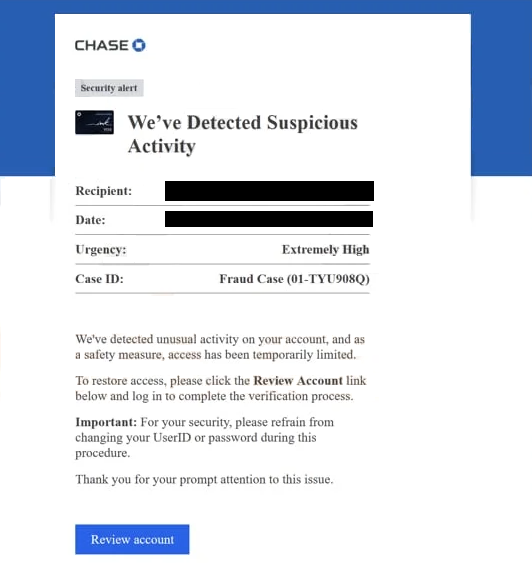Remove “Chase – Suspicious Activity” phishing email
The “Chase – Suspicious Activity” email is part of a phishing campaign that claims unusual activity has been detected on users’ Chase accounts. According to the email, users need to review their accounts for security reasons. The email is targeting users’ login credentials, and if users fall for this phishing attempt, their Chase accounts could be compromised. This is a fairly sophisticated phishing attempt as the email looks legitimate at first glance. Unfortunately, this means that many users may fall for it.
The “Chase – Suspicious Activity” phishing email targets Chase customers and aims to steal their online bank login credentials. It goes without saying that Chase is in no way related to this phishing email. The email falsely informs recipients that unusual activity was detected on the account and access to the account has been limited. Recipients are asked to review their accounts by clicking on the provided button. The email also mentions that recipients should not change their UserID or password until verification is complete.
This email is a phishing scam so if users click on the “Review account” button, they’ll be redirected to a website that looks similar to the official Chase site. The phishing site prompts users to enter their usernames and passwords to log in. If users do so, their login information will be captured by the cybercriminals behind this phishing attack. With this stolen information, these malicious actors could gain access to users’ accounts and may carry out unauthorized purchases or transfers.
The full “Chase – Suspicious Activity” email is below:
Subject: Restricted Access: Secure Your Account Now
Chase
Security alert
We’ve Detected Suspicious ActivityRecipient: (-)
Date: Friday, January 3, 2025 8:22 a.m. ET
Urgency: Extremely High
Case ID: Fraud Case (01-TYU908Q)We’ve detected unusual activity on your account, and as a safety measure, access has been temporarily limited.
To restore access, please click the Review Account link below and log in to complete the verification process.
Important: For your security, please refrain from changing your UserID or password during this procedure.
Thank you for your prompt attention to this issue.
Review account
Securely access your accounts with the Chase Mobile® app or chase.com.
Signs of a phishing email
Phishing campaigns that target many users with the same identical email are often easy to recognize due to their generic nature. These emails typically lack specific details and are often riddled with all kinds of mistakes. More sophisticated phishing attempts are usually reserved for specific people whose personal data has been stolen by cybercriminals. These tailored emails usually appear much more legitimate, increasing the chances of users falling victim to them.
If you receive an unsolicited email requesting you to click on a link or open an attachment, the first step is to check the sender’s email address. A quick Google search can help verify if the address belongs to the person or organization it claims to represent. Generic malicious emails tend to be sent from random-looking addresses, while more sophisticated phishing attempts often use email addresses that resemble those of reputable companies or organizations. In this “Chase – Suspicious Activity” phishing email’s case, the email address clearly does not belong to Chase as it looks very unprofessional.
Another telltale sign of a phishing email is grammar and spelling mistakes. Malicious emails frequently contain mistakes, often very obvious ones. This particular “Chase – Suspicious Activity” email is more sophisticated so there are no obvious mistakes but that’s quite rare.
We advise you not to rush into action when dealing with emails that prompt you to click links or open attachments. Instead, take the time to inspect the email and assess its legitimacy. If an email includes a link, hover over it to see its actual destination before clicking. For attachments, use an anti-virus program or a service like VirusTotal to scan them before opening them. If the email claims there’s a problem with your account, avoid clicking any links; instead, log in to your account directly to verify any issues. Finally, always check the URL of a website before logging in. Phishing sites can closely mimic legitimate ones in design, but their URLs will never look the same.
Remove “Chase – Suspicious Activity” email
If you receive this email, don’t hesitate to delete “Chase – Suspicious Activity” email from your inbox. If you hold an account with this bank, pay no attention to the contents as the email is fake. If you’ve interacted with it and entered your login details on a phishing site, you must reach out to the bank immediately. Let them know you may have fallen victim to a phishing scam and that your account could be at risk. Taking immediate action is essential to prevent any unauthorized access or transactions on your account.
Site Disclaimer
WiperSoft.com is not sponsored, affiliated, linked to or owned by malware developers or distributors that are referred to in this article. The article does NOT endorse or promote malicious programs. The intention behind it is to present useful information that will help users to detect and eliminate malware from their computer by using WiperSoft and/or the manual removal guide.
The article should only be used for educational purposes. If you follow the instructions provided in the article, you agree to be bound by this disclaimer. We do not guarantee that the article will aid you in completely removing the malware from your PC. Malicious programs are constantly developing, which is why it is not always easy or possible to clean the computer by using only the manual removal guide.

